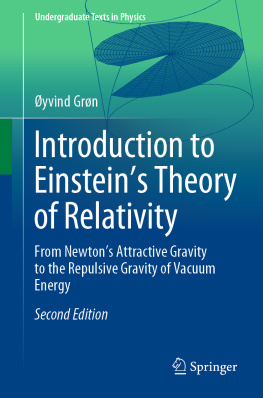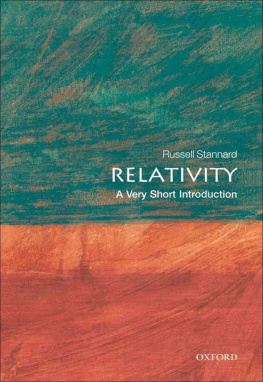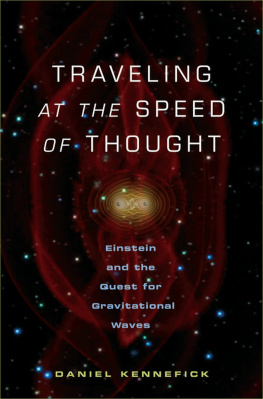Hermann Weyl - Space, Time, Matter
Here you can read online Hermann Weyl - Space, Time, Matter full text of the book (entire story) in english for free. Download pdf and epub, get meaning, cover and reviews about this ebook. year: 1952, publisher: Dover Publications, genre: Religion. Description of the work, (preface) as well as reviews are available. Best literature library LitArk.com created for fans of good reading and offers a wide selection of genres:
Romance novel
Science fiction
Adventure
Detective
Science
History
Home and family
Prose
Art
Politics
Computer
Non-fiction
Religion
Business
Children
Humor
Choose a favorite category and find really read worthwhile books. Enjoy immersion in the world of imagination, feel the emotions of the characters or learn something new for yourself, make an fascinating discovery.
- Book:Space, Time, Matter
- Author:
- Publisher:Dover Publications
- Genre:
- Year:1952
- Rating:5 / 5
- Favourites:Add to favourites
- Your mark:
- 100
- 1
- 2
- 3
- 4
- 5
Space, Time, Matter: summary, description and annotation
We offer to read an annotation, description, summary or preface (depends on what the author of the book "Space, Time, Matter" wrote himself). If you haven't found the necessary information about the book — write in the comments, we will try to find it.
Space, Time, Matter — read online for free the complete book (whole text) full work
Below is the text of the book, divided by pages. System saving the place of the last page read, allows you to conveniently read the book "Space, Time, Matter" online for free, without having to search again every time where you left off. Put a bookmark, and you can go to the page where you finished reading at any time.
Font size:
Interval:
Bookmark:
SPACETIME
MATTER
BY
HERMANN WEYL
TRANSLATED FROM THE GERMAN BY
HENRY L. BROSE
WITH FIFTEEN DIAGRAMS
DOVER PUBLICATIONS, INC.
This Dover edition, first published in 1952, is an unabridged and unaltered republication of the fourth edition. It is published by special arrangement with Methuen & Company, Ltd.
International Standard Book Number: 0-486-60267-2
Library of Congress Catalog Card Number: A52-9277
Manufactured in the United States by Courier Corporation
60267224
www.doverpublications.com
PREFACE TO THE FIRST AMERICAN PRINTING
T HIS translation is made from the fourth edition of RAUM ZEIT MATERIE which was published in 1921. Relativity theory as expounded in this book deals with the space-time aspect of classical physics. Thus, the books contents are comparatively little affected by the stormy development of quantum physics during the last three decades. This fact, aside from the publics demand, may justify its re-issue after so long a time. Of course, had the author to re-write the book today, he would take into account certain events that have modified the situation in the intervening years. I mention three such points.
(1) The principle of general relativity had resulted above all in a new theory of the gravitational field. While it was not difficult to adapt also Maxwells equations of the electromagnetic field to this principle, it proved insufficient to reach the goal at which classical field physics is aiming: a unified field theory deriving all forces of nature from one common structure of the world and one uniquely determined law of action. In the last two of its 36 sections, my book describes an attempt to attain this goal by a new principle which I called gauge in variance (Eichin-varianz). This attempt has failed. There holds, as we know now, a principle of gauge invariance in nature; but it does not connect the electromagnetic potentials i, as I had assumed, with Einsteins gravitational potentials gik, but ties them to the four components of the wave field by which Schrdinger and Dirac taught us to represent the electron. For this and the following points, compare my book, GRUPPENTHEORIE UND QUANTEN-MECHANIK , Leipzig 1928, 2nd ed. 1931, the article, Elektron und Gravitation in Zeitschr.f. Physik 56, 1929, p. 330, and my Rouse Ball lecture Geometry and Physics in Naturwissen-schaften 19, 1931, pp. 49-58. Of course, one could not have guessed this before the electronic field was discovered by quantum mechanics! Since then, however, a unitary field theory, so it seems to me, should encompass at least these three fields: electromagnetic, gravitational and electronic. Ultimately the wave fields of other elementary particles will have to be included toounless quantum physics succeeds in interpreting them all as different quantum states of one particle.
(2) Quite a number of unified field theories have sprung up in the meantime. They are all based on mathematical speculation and, as far as I can see, none has had a conspicuous success. Kaluzas five-dimensional theory, particularly in the garb of projective relativity, has been investigated and extended by several authors. The most recent attempts by Schrodinger and by Einstein combine Eddingtons idea of an affine field theory with that of dropping the requirement of symmetry for the metric tensor gik and the components  of the affine connection. Of the extensive literature I mention here only: E. Schrdinger, The Final Affine Field Laws, in Proc. Roy. Irish Ac. (A) 51, pp. 163-171, 205-216; 52, pp. 1-9 (1947/48); A. Einstein, THE MEANING OF RELATIVITY , 3rd ed., Princeton, N. J., 1949, Appendix II; Schrdingers book, SPACE-TIME STRUCTURE announced by Macmillan, and my lecture 50 Jahre Relativitts-theorie at the first post-war meeting of the Gessellschaft deutscher Naturforscher und Aerzte (Munich, Oct. 1950, to be published soon). One non-speculative development which deserves mention is Einsteins mixed metric-affine formulation in which both the gik and the
of the affine connection. Of the extensive literature I mention here only: E. Schrdinger, The Final Affine Field Laws, in Proc. Roy. Irish Ac. (A) 51, pp. 163-171, 205-216; 52, pp. 1-9 (1947/48); A. Einstein, THE MEANING OF RELATIVITY , 3rd ed., Princeton, N. J., 1949, Appendix II; Schrdingers book, SPACE-TIME STRUCTURE announced by Macmillan, and my lecture 50 Jahre Relativitts-theorie at the first post-war meeting of the Gessellschaft deutscher Naturforscher und Aerzte (Munich, Oct. 1950, to be published soon). One non-speculative development which deserves mention is Einsteins mixed metric-affine formulation in which both the gik and the  are taken as quantities capable of independent virtual variation; cf. Einstein, Sitzungsber. Preuss. Ah. Wissensch. 1925, p. 414; H. Weyl, Phys. Review 77, 1950, pp. 699-701.
are taken as quantities capable of independent virtual variation; cf. Einstein, Sitzungsber. Preuss. Ah. Wissensch. 1925, p. 414; H. Weyl, Phys. Review 77, 1950, pp. 699-701.
(3) A new development began for relativity theory after 1925 with its absorption into quantum physics. The first great success was scored by Diracs quantum mechanical equations of the electron, which introduced a new sort of quantities, the spinors, besides the vectors and tensors into our physical theories. See Diracs book, THE PRINCIPLES OF QUANTUM MECHANICS , 3rd ed., Oxford, Clarendon Press, 1947. The generally relativistic formulation of these equations offered no serious difficulties. But difficulties of the gravest kind turned up when one passed from one electron or photon to the interaction among an indeterminate number of such particles. In spite of several promising advances a final solution of this problem is not yet in sight and may well require a deep modification of the foundations of quantum mechanics, such as would account in the same basic manner for the elementary electric charge e as relativity theory and our present quantum mechanics account for c and h.
Zurich, October 1950
HERMANN WEYL
FROM THE AUTHORS PREFACE TO
THE FIRST EDITION
E INSTEINS Theory of Kelativity has advanced our ideas of the structure of the cosmos a step further. It is as if a wall which separated us from Truth has collapsed. Wider expanses and greater depths are now exposed to the searching eye of knowledge, regions of which we had not even a presentiment. It has brought us much nearer to grasping the plan that underlies all physical happening.
Although very recently a whole series of more or less popular introductions into the general theory of relativity has appeared, nevertheless a systematic presentation was lacking. I therefore considered it appropriate to publish the following lectures which I gave in the Summer Term of 1917 at the Eidgen. Technische Hochschule in Zrich. At the same time it was my wish to present this great subject as an illustration of the intermingling of philosophical, mathematical, and physical thought, a study which is dear to my heart. This could be done only by building up the theory systematically from the foundations, and by restricting attention throughout to the principles. But I have not been able to satisfy these self-imposed requirements : the mathematician predominates at the expense of the philosopher.
The theoretical equipment demanded of the reader at the outset is a minimum. Not only is the special theory of relativity dealt with exhaustively, but even Maxwells theory and analytical geometry are developed in their main essentials. This was a part of the whole scheme. The setting up of the Tensor Calculusby means of which, alone, it is possible to express adequately the physical knowledge under discussion occupies a relatively large amount of space. It is therefore hoped that the book will be found suitable for making physicists better acquainted with this mathematical instrument, and also that it will serve as a text-book for students and win their sympathy for the new ideas.
HEKMANN WEYL
R IBRITZ IN M ECKLENBURG
Easter, 1918
PREFACE TO THE THIRD EDITION
A LTHOUGH this book offers fruits of knowledge in a refractory shell, yet communications that have reached me have shown that to some it has been a source of comfort in troublous times. To gaze up from the ruins of the oppressive present towards the stars is to recognise the indestructible world of laws, to strengthen faith in reason, to realise the harmonia mundi that transfuses all phenomena, and that never has been, nor will be, disturbed.
Next pageFont size:
Interval:
Bookmark:
Similar books «Space, Time, Matter»
Look at similar books to Space, Time, Matter. We have selected literature similar in name and meaning in the hope of providing readers with more options to find new, interesting, not yet read works.
Discussion, reviews of the book Space, Time, Matter and just readers' own opinions. Leave your comments, write what you think about the work, its meaning or the main characters. Specify what exactly you liked and what you didn't like, and why you think so.











